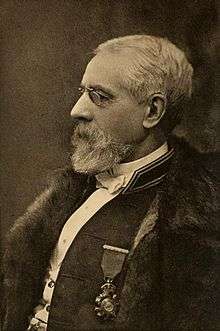Henry George Keene (1826–1915)
Henry George Keene (1826–1915) was an English historian of medieval and modern India.[1]

Life
Keene was born at the East India College, Haileybury; Henry George Keene (1781–1864) was his father.[2] He was educated at Rugby School and Wadham College, Oxford, going to India as an East India Company employee in 1847. His career as an official was limited, but he began to write.[3]
From 1847 to 1882 Keene served in the Bengal Civil Service. During the Indian Rebellion of 1857 he was Superintendent at Debea Dow. From 1867 he was a judge in the North-West Provinces. A Fellow of Calcutta College, he was made C.I.E. in 1883.[4][5]
Works
Keene's books included:
- Chabeena. Trivial talk on Indian topics. By a wayfarer (1865), as H. G. K.[6] Contains discussion of John Stuart Mill's justification for British rule.[7]
- Fifty-Seven: some account of the administration in Indian districts during the revolt of the Bengal army (1883)
- A Sketch of the History of Hindustan, from the first Muslim Conquest to the Fall of the Mughol Empire (1885)[8]
- The Fall of the Moghal Empire of Hindustan (1887)[9] or The Moghul empire; from the death of Aurungzeb to the overthrow of the Mahratta power
- (ed.) An Oriental Biographical Dictionary, based on materials collected by Thomas William Beale (1894) online; concerned largely with Islamic Indian biographies.[10]
- Servant of "John Company" (1897)[11]
- History of India Vol. 1: From the Earliest Times to the End of the Nineteenth Century, for the Use of Students and Colleges (1906)
- Here and There: Memories, Indian and Other (1906)
- Hindustan Under Free Lances, 1770-1820: Sketches of Military Adventure in Hindustan (1907)[11]
- Turks in India: Critical Chapters on the Administration of That Country by the Chughtai, Babar, and His Descendants
- St George's Cross - An Episode of Channel Island History
- British Administration During the Revolt of 1857
- Madhava Rao Sindhia and the Hindú reconquest of India
"Keene's Handbooks" covered a number of Indian cities.[12] He also wrote for the Dictionary of National Biography and Chambers's Encyclopaedia.[13]
Notes
- ↑ George Sampson (1941). The Concise Cambridge History of English Literature. CUP Archive. pp. 912–. GGKEY:2J1T4J40K28.
- ↑ "Rugby School Register, 1675-1842, Volume 1, Page 339". Retrieved 15 June 2014.
- ↑ s:The Times/1915/Obituary/Henry George Keene
- ↑ Robert Barlow Gardiner, The Registers of Wadham College, Oxford vol. 2 (1889), pp. 412–3; archive.org.
- ↑ Great Britain. India Office (1819). The India List and India Office List for ... Harrison and Sons. p. 162.
- ↑ Henry George Keene the younger (1865). Chabeena. Trivial talk on Indian topics.
- ↑ Gregory Claeys (9 May 2013). Mill and Paternalism. Cambridge University Press. p. 100 note 181. ISBN 978-0-521-76108-6.
- ↑ Waldemar Hansen (1 January 1986). The Peacock Throne: The Drama of Mogul India. Motilal Banarsidass Publ. p. 542. ISBN 978-81-208-0225-4.
- ↑ Allyn Miner (1 January 1997). Sitar and Sarod in the 18th and 19th Centuries. Motilal Banarsidass Publ. p. 246. ISBN 978-81-208-1493-6.
- ↑ Ronald H. Fritze; Brian E. Coutts; Louis Andrew Vyhnanek (2004). Reference Sources in History: An Introductory Guide. ABC-CLIO. p. 321. ISBN 978-0-87436-883-3.
- 1 2 Michael H. Fisher (2006). Counterflows to Colonialism: Indian Travellers and Settlers in Britain, 1600-1857. Orient Blackswan. p. 454. ISBN 978-81-7824-154-8.
- ↑ Aparajita Mukhopadhyay, Wheels of Change? Impact of Railways on Colonial North Indian Society, 1855–1920, (PDF), at p. 115, note 441.
- ↑ s:The Indian Biographical Dictionary (1915)/Keene, Henry George
External links
| Wikisource has original works written by or about: Henry George Keene |